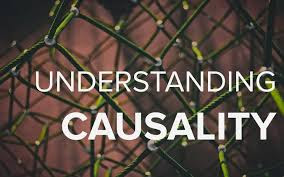Causality can be best explained as the study of how things influence one other and how causes lead to effects. Causality is also sometimes referred to as causation, or cause and effect. It is influenced by some event, process, state, or object, a cause that contributes to the production of another event, process, state, or object, an effect where the cause is partly responsible for the effect, and the effect is partly dependent on the cause.
The first big rule of classical causality is that things have causes. They don’t just happen of their own accord. If a ball moves, there are chances that someone kicked it; if an apple falls from a tree, it is because its weight became too great for the branch to carry it further from which it was hanging.
An assignment help firm would not be wrong to say that a process has many causes, which are also said to be causal factors for it, and all lie in its past. An effect can, in turn, be a cause of, or causal factor for, many other effects, which all lie in its future. Some researchers also believe causality to be metaphysically before notions of time and space.
Causality is an abstraction that indicates how the world progresses. The basic concept is that it is more apt as an explanation of other concepts of progression than as something to be explained by others more basic. The concept is like those of agency and efficacy. Accordingly, causality is implicit in the logic and structure of ordinary language.
It can be best explained with real-life examples. When you smoke more, you are at a higher risk of developing lung diseases. In the same way, the more you study, the better job prospects you can look forward to enjoying in the long run. The more money you make, the better living standard you can enjoy. In all these cases, a change in the independent variable correlates or is associated with, a change in a dependent variable.
If there is no association, there will be no causal relationship. For instance, empirically there seems to be no correlation between the use of the death penalty and a reduction in the rate of serious crime. That may seem unlikely to you, but empirically it is the case: There is no correlation. So there cannot be a causal relationship.
We are told that we must believe in ourselves to be successful or do well in the long run. Very successful politicians, actors, and business people indeed seem remarkably confident and sure of themselves and there is an association. But it is also necessary to know that their confidence is the result of their success, not its cause.
This factor is best explained with examples that show correlation but there can be some other factors at work too. It is believed that schools with better resources produce better students. It might be true, but parents with more education and higher income tend to live in posh neighborhoods spend more on their schools. Also, they are more likely to get the best books and other advantages to their children, and maybe their income causes variation in both school resources and student performance. If so, there would be an association between school resources and student performance, but it would be least partially spurious.
The measure of association is any statistic that shows, in a single number, the degree of relationship between two variables. To prove causation, researchers need to establish correlation and time order and rule out alternative explanations.
Most social scientific studies aim to provide some kind of causal explanation. Causation and the means for achieving causally valid conclusions play a very important in evaluating the extent to which research can achieve causally valid findings. Researchers need to work on the variables and the findings to reach appropriate causal conclusions.
The first big rule of classical causality is that things have causes. They don’t just happen of their own accord. If a ball moves, there are chances that someone kicked it; if an apple falls from a tree, it is because its weight became too great for the branch to carry it further from which it was hanging.
An assignment help firm would not be wrong to say that a process has many causes, which are also said to be causal factors for it, and all lie in its past. An effect can, in turn, be a cause of, or causal factor for, many other effects, which all lie in its future. Some researchers also believe causality to be metaphysically before notions of time and space.
Causality is an abstraction that indicates how the world progresses. The basic concept is that it is more apt as an explanation of other concepts of progression than as something to be explained by others more basic. The concept is like those of agency and efficacy. Accordingly, causality is implicit in the logic and structure of ordinary language.
Factors Needed To Support Causality
The three factors that are considered necessary for identifying a causal effect are:- Empirical association
- Temporal priority of the independent variable, and
- Non-spuriousness
It Is Important to Establish These Three to Claim a Causal Relationship.
Empirical Association
The empirical association is one of the most crucial factors that help to establish a causal effect. Also known as an observed association or also a correlation between the independent and dependent variables, they must work together so that efficient results can be obtained. When one variable goes up or down, the other should also go up and down at the same time to establish an association.It can be best explained with real-life examples. When you smoke more, you are at a higher risk of developing lung diseases. In the same way, the more you study, the better job prospects you can look forward to enjoying in the long run. The more money you make, the better living standard you can enjoy. In all these cases, a change in the independent variable correlates or is associated with, a change in a dependent variable.
If there is no association, there will be no causal relationship. For instance, empirically there seems to be no correlation between the use of the death penalty and a reduction in the rate of serious crime. That may seem unlikely to you, but empirically it is the case: There is no correlation. So there cannot be a causal relationship.
Temporal Priority
Association is significant for establishing a causal effect, but it is not sufficient. It is also necessary to ensure that the variation in the independent variable came before variation in the dependent variable; the cause must come before its presumed effect. It is the criterion of time order or the temporal priority of the independent variable.We are told that we must believe in ourselves to be successful or do well in the long run. Very successful politicians, actors, and business people indeed seem remarkably confident and sure of themselves and there is an association. But it is also necessary to know that their confidence is the result of their success, not its cause.
Until You Know Which Came First, You Cannot Establish A Causal Connection.
Non-Spuriousness
Non-spuriousness is the third factor that helps to establish causality. Spurious means false or not genuine. A relationship between two variables is called spurious when it is actually due to changes in a third variable, so what appears to be a direct connection is not one. An association between two variables might be caused by something else. The association between the two is, we say, spurious.This factor is best explained with examples that show correlation but there can be some other factors at work too. It is believed that schools with better resources produce better students. It might be true, but parents with more education and higher income tend to live in posh neighborhoods spend more on their schools. Also, they are more likely to get the best books and other advantages to their children, and maybe their income causes variation in both school resources and student performance. If so, there would be an association between school resources and student performance, but it would be least partially spurious.
How Do Researchers Establish Causation?
To establish the relation between cause and effect, the researcher must take into account all the possible alternative causes of the relationship between the two variables. Regardless of their temporal order, variables may be associated with one another because they are both effects of the same cause.The measure of association is any statistic that shows, in a single number, the degree of relationship between two variables. To prove causation, researchers need to establish correlation and time order and rule out alternative explanations.
Correlation And What Is Its Relationship To Causation
The cheap dissertation help firm’s expert view is that a correlation between variables does not automatically mean that the change in one variable is the cause of the change in the values of the other variable. Causation indicates that one event is the result of the occurrence of the other event, i.e. there is a causal relationship between the two events.Most social scientific studies aim to provide some kind of causal explanation. Causation and the means for achieving causally valid conclusions play a very important in evaluating the extent to which research can achieve causally valid findings. Researchers need to work on the variables and the findings to reach appropriate causal conclusions.








Post a Comment
0 Comments